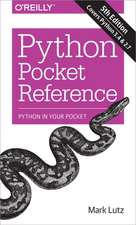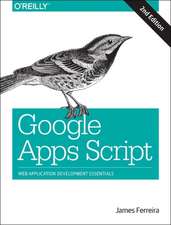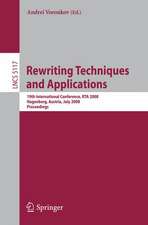Python and AWS Cookbook: Oreilly Cookbooks
Autor Mitch Garnaaten Limba Engleză Paperback – 24 noi 2011
Preț: 144.85 lei
Preț vechi: 181.06 lei
-20% Nou
Puncte Express: 217
Preț estimativ în valută:
27.72€ • 29.02$ • 22.93£
27.72€ • 29.02$ • 22.93£
Carte tipărită la comandă
Livrare economică 07-21 aprilie
Preluare comenzi: 021 569.72.76
Specificații
ISBN-13: 9781449305444
ISBN-10: 144930544X
Pagini: 76
Dimensiuni: 178 x 217 x 4 mm
Greutate: 0.14 kg
Editura: O'Reilly
Seria Oreilly Cookbooks
ISBN-10: 144930544X
Pagini: 76
Dimensiuni: 178 x 217 x 4 mm
Greutate: 0.14 kg
Editura: O'Reilly
Seria Oreilly Cookbooks
Cuprins
Preface; Conventions Used in This Book; Using Code Examples; Safari® Books Online; How to Contact Us; Chapter 1: General Info; 1.1 A Quick Note About Python; 1.2 Installing boto; 1.3 Getting Started with Amazon Web Services; 1.4 Using boto with Eucalyptus; 1.5 Using boto with Google Cloud Storage; 1.6 Finding Available Regions for AWS; 1.7 Enabling Debug Output with boto; 1.8 Controlling Socket Timeouts in boto; Chapter 2: EC2 Recipes; 2.1 Launching an Instance; 2.2 Keeping Track of Instances with Tags; 2.3 Accessing the Console Log; 2.4 Uploading Your Own SSH Keypair; 2.5 Synchronizing SSH Keypairs Across EC2 Regions; 2.6 Associate an Elastic IP Address with an Instance; 2.7 Attach a Persistent EBS Volume to an Instance; 2.8 Back Up Your EBS Volumes; 2.9 Restore a Volume from a Snapshot; 2.10 Clone an Existing Instance; 2.11 Find All Running EC2 Instances; 2.12 Monitoring the Performance of Your Instance; 2.13 Getting Notifications; 2.14 Storing Custom Data in CloudWatch; 2.15 Executing Custom Scripts upon Instance Startup; Chapter 3: S3 Recipes; 3.1 Create a Bucket; 3.2 Create a Bucket in a Specific Location; 3.3 Store Private Data; 3.4 Store Metadata with an Object; 3.5 Computing Total Storage Used by a Bucket; 3.6 Copy an Existing Object to Another Bucket; 3.7 Modify the Metadata of an Existing Object; 3.8 Find Out Who Is Accessing Your Data; 3.9 Reduce the Cost of Storing Noncritical Data; 3.10 Generating Expiring URLs for S3 Objects; 3.11 Preventing Accidental Deletion of Data from S3; 3.12 Hosting Static Websites on S3; 3.13 Uploading Large Objects to S3;















